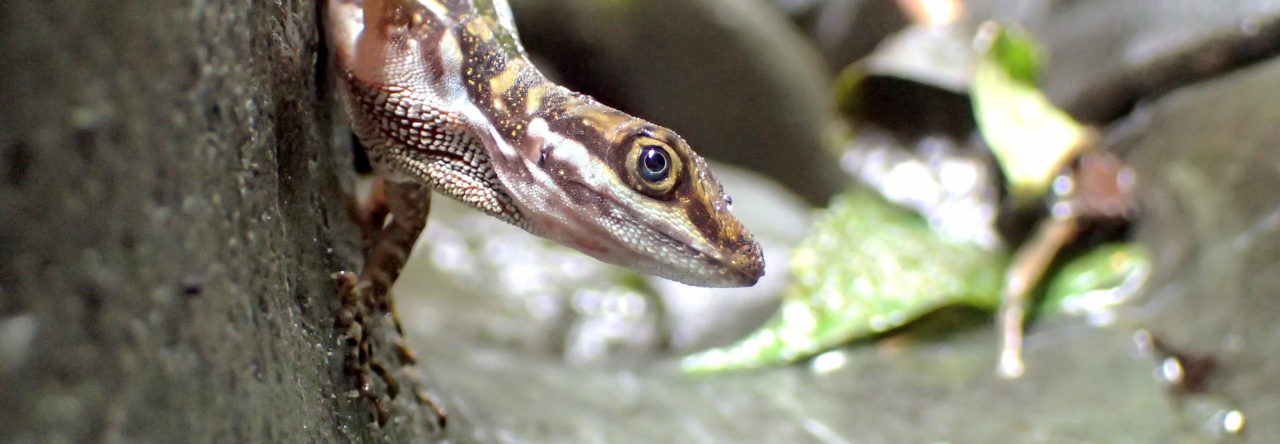The title of the paper says it all: “It is time for a new classification of anoles (Squamata: Dactyloidae).” No doubt, AA contributors will have something to say about this before long, but comments–or posts–are welcome now. The paper–by Nicholson, Crother, Guyer, and Savage–is a 108 page monograph in Zootaxa (text runs to page 69). Anolis is proposed to be split into the following genera: Dactyloa, Deiroptyx, Xiphosurus, Chamaelinorops, Audantia, Anolis, Ctenonotus, and Norops. In addition to presenting a phylogeny and a new classification, the paper also has sections on biogeography, dating, ancestor reconstruction and–most intriguingly–“Evolution of ecomodes in the family Dactyloidae.” Stay tuned!
- Evolution in Real Time on Lizard Island - March 23, 2025
- Spider Snags Adult Anolis osa - March 22, 2025
- An Homage to the Green Anoles of New Orleans - March 21, 2025


Rich Glor
I urge readers of Anole Annals to refrain from adopting Nicholson et al.’s taxonomic arrangement until members of the anole systematics community have had an opportunity to critically evaluate the proposed changes.
Skip Lazell
I agree with Rich. This has, of course, been done before. It is useless, except to the pet trade, who get lots more for a “Ctenonotus cristatellus” than for an Anolis cristatellus. Anolis sensu lato is just fine.
Cachí
If we can recognize the series and groups of anoles as evolutionary entities by mean of morphological and molecular approaches, we can name this entities by separate.
On a psychological level we require those names to speak more clearly of the animal groups we studied. We have called Beta series for the anoles in the mainland and some areas of the Caribbean. Then, why not just call Norops. Similarly other groups of anoles demand their own name.
Skip Lazell
Cachi: The problem is that there are no simple, consistent characters to identify the members of these groups. Taxonomic names should be a handy convenience, not a pet-trade money-making gimmick.
Barnaby
I’m fairly certain the authors’ intent was not to make money in the pet trade. But maybe you know something about these folks that I don’t.
David Hillis
There is considerable value to keeping generic names stable. There is also value to naming well-supported clades on the tree of life, so that we have names to use for well-supported monophyletic groups. But there is no need to take a widely used name like Anolis, and to name a bunch of genera within it, and then insist that everyone use new combinations of genus + species. Why not just recognize that there is indeed a subgeneric clade Norops within the genus Anolis? Then the species names do not need to change, but we can all refer to the various distinct clades within Anolis when we have a need to do so. The practice of subdividing perfectly monophyletic genera into huge numbers of smaller genera is causing massive confusion of the taxonomic literature, and it is not helping anyone. For more discussion of this point, see: Pauly, G. B., D. C. Cannatella, and D. M. Hillis. 2009. Taxonomic freedom and the role of official lists of species names. Herpetologica 65:115-128.
Liam Revell
Like.
Mason Ryan
Like!
Brian Crother
Pauly et al. are not the only or final word. See also Crother 2009, Are standard names lists taxonomic straightjackets. Herpetologica, 65(2), 2009, 129–135 and Response to the Point of View of Gregory B. Pauly, David M. HILLIS, And David C. Cannatella, by the Anuran Subcommittee of the SSAR/HL/ASIH Scientific and Standard English Names List by Darrel R. Frost, Roy W. McDiarmid, and Joseph R. Mendelson, III in the same issue of Herpetologica.
William E. Duellman
Nicholson et al have a weakly supported tree based on mitochondrial data. I suspect that nuclear data will change the picture that they present. Nevertheless, the recognition of a bunch of genera is unnecessary and undesirable. Yes, names should reflect classifications based on phylogenetic analyses, but splitting of a well-known genus into several genera does not solve the problem. Use of the generic name Ctenonotus does not reflect the fact that it is an anole. Generic names are handles, so we can speak and write about them in a way that the audience understands the context. The problem with Anolis and other large groups can be handled most effectively by the use of subgenera, as done effectively by David Wake for Bolitoglossa (2012, Zootaxa, 3484)
Fernando J. Bird-Picó
Agree with Hillis & Duellman… Is the date of publication (9/11) a doomsday sign of taxonomic stability?